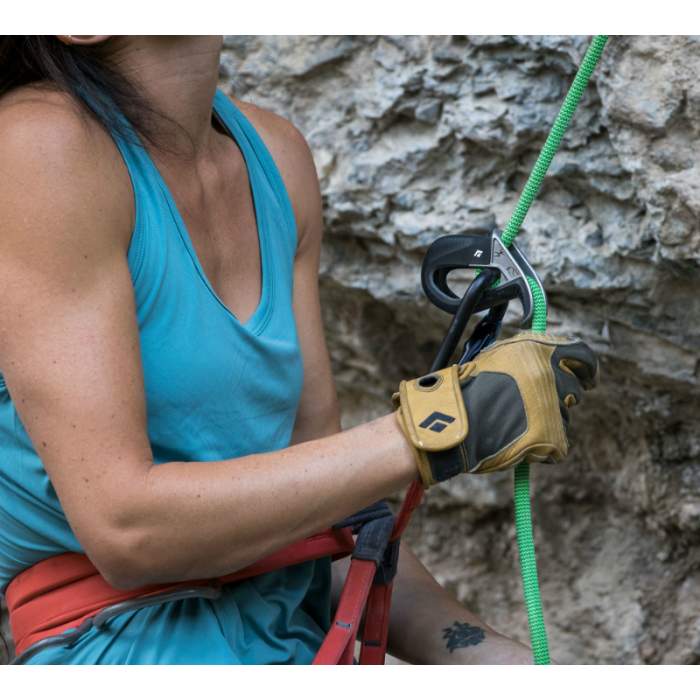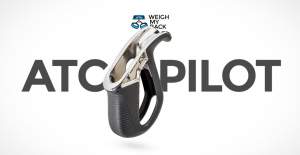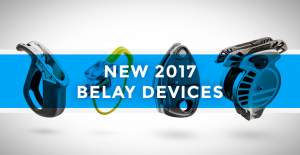ATC Pilot
Description
An all-new geometry assisted braking device, the ATC Pilot introduces a system that provides an added level of security to your belay, while allowing for smooth rope payout.
The lightweight Black Diamond ATC Pilot represents an advance in technology for the world of assisted braking devices. Providing an added level of security to your belay, the ATC Pilot threads similarly to other tubular belay devices and accommodates ropes from 8.7-10.5mm. The durable steel braking surface has no moving parts, and the smooth and secure control allows for gradual lowering. With an easy rope payout, the ATC Pilot makes single-pitch projecting burns less tiring for the belayer and more secure for the climber.
- Provides an added level of security to single pitch belays
- Smooth rope payout
- Controlled lowering
- Steel construction
- Ergonomic, non-slip surface
- Single rope use
Retail price
When you click a link below and then checkout online, no matter what you buy (climbing gear or not), we get a small commission that helps us keep this site up-to-date. Thanks!

Device Type  Device TypeTubeThe most commonly used belay type also called an “ATC” or “tuber.” Other than a distinction between other belay device types, “Tube” is a rarely used term, most climbers just assume you're talking about this style when they refer to your "belay device." 
Figure 8Mostly used in rescue, canyoneering, tactical, work safety, or by old school climbers and rappellers. One reason they went out of popularity with recreational climbers is because they tend to create twists in the rope. 
Brake AssistThese devices assist in stopping the rope when a climber falls or hangs on the rope. 
Often referred to as “auto-blocking” but that’s not the official terminology because no belay device should be assumed to work automatically by itself, even if it feels like it does (or does most the time). PlateWhen simplicity is a must, or you started climbing before Tubers were the norm. Bonus: They tend to be very light weight. 
DescenderFor rappelling, not for belaying a lead climber or top-roping.  |
Brake Assist - Tube |
Weight (g)  Weight (g)In grams, the weight, as stated by the manufacturer/brand. |
86 g |
Belay Brake Assist  Belay Brake AssistThis is when the belay device significantly reduces the amount of holding power the belayer must exert to stop a fall and hold a climber. This is also called "assisted-braking" as the device must hold a significant amount of the climber’s weight; this term does not include friction-adding "teeth" found on some tube style belay devices. Confusingly referred to as “auto-blocking” or “auto-locking” these terms wrongly imply the device will always, automatically, stop a fall or hold a climber even if the belayer/rappeller is hands-free. These devices are not meant to be used without a hand on the braking side of the rope; the belayers/rapppeller brake hand should always be on the brake rope. Worth ConsideringMost of the mechanical brake assist devices only hold a single strand of rope and are not capable of double-strand rappelling (the most common method of rappel). |
Yes |
| Rope Options | 1 rope only |
Guide Mode  Guide ModeThis is when you belay directly off the anchor instead of your harness. Guide mode is helpful if you climb outdoors a lot because it reduces the holding power required from the belayer. When your partner falls or rests, the weight of the climber is held mostly by the anchor and the belay device. Tubers and PlatesWhen belaying in "guide mode," the tubers and plates turn auto-blocking. During a fall, the climbing rope pinches the slack rope, completely stopping the movement of either rope. A common guide mode setup shown below. 
Mechanical Brake Assist DevicesThere is no difference in the functionality of the device. A brake-hand should always be on the rope to ensure the climber is caught in the case of a fall. A common guide mode setup shown below. 
Where guide mode is used
Learn Morehttp://www.climbing.com/skill/essential-skills-auto-blocking-belay-devices/ |
No guide mode |
Teeth  TeethTeeth are only seen on tube devices. They add friction that helps grip the rope for more belaying control. This is helpful for belaying heavier climbers. Teeth are becoming standard on new tube devices. 
Worth ConsideringTeeth do wear out. You can limit wear by rappelling on the side without teeth (if you don’t need the extra friction). Once they’re worn, you’ll still have a usable belay device, just less friction. |
No |
Rope Range (mm)  Rope Range (mm)The range of rope diameters, in millimeters, that the manufacturer/brand specifies can safely be used. This is the best case scenario and does not necessarily take into consideration that certified ropes have a tolerance of +/- .3 mm. Recently, manufacturers have started to add an "optimized" rope range -- this is the range that will result in the nicest handling of the belay device. | 8.7 mm - 10.5 mm |
Certification  CertificationsThe main climbing gear certifications are CE and UIAA--and normally the UIAA creates the rules that the CE body also supports. When possible, we try to list all the certifications the product carries. To sell a climbing product in Europe, the device must be CE certified. There are no official requirements to sell climbing gear in the US. The UIAA certification is a voluntary process. Learn MoreRock and Ice Certifications Guide |
|
Easy to use, easy to learn
by lobstertronic@g... on 11/21/2018Until a better one, this is the best one~
by anonymous on 01/6/2018Overall, the Pilot gets my thumbs-up for single-pitch climbing. Whether in the gym or outside, I most like it for belaying my climbing partner on her “proj,” or for those just learning to climb.
If your first thought upon looking at the Black Diamond ATC Pilot is "what's the point of this device?" you wouldn't be alone! However, it does serve a useful purpose for certain scenarios, and we can see gyms that like to have a pre-rigged GriGri on every toprope opt for the Pilot instead due to the cost savings. It also shaves a couple of ounces off your rack, so if you're looking to lighten up all of your gear, this will help you towards that goal.
The Black Diamond ATC Pilot is a great addition to the growing amount of assisted braking devices on the market. While it’s obvious this would be a good tool for gym and sport climbers we believe it could also earn a place with climbing guides and instructors. It’s an excellent choice for a new belayer due to its intuitive use and extra layer of security it provides while maintaining a simple design. The symmetrical design also makes this device equally effective for those who are right or left handed, something that many similar devices do not do. We also find the light weight and competitive price of this device to be a compelling reason to add it to your kit.
The ATC Pilot is Black Diamond’s offering to this increasingly competitive corner of the market, and at just 92g is one of the lightest assisted braking devices available and can accommodate ropes from 8.7-10.5mm in diameter. Unlike the Petzl Grigri, it contains no moving parts, instead relying on the rope being pinched between the belay-carabiner and Pilot at a particular angle. This system not only benefits the belayer by reducing the strain on them, but also aids the climber, giving them piece of mind that unless something truly disastrous happens, each and every one of their falls will be successfully caught. Of course using one of these devices does not mean you can afford to be a lazy belayer.
I liked it more than I thought I would, thanks to the smooth, controlled lowers and the ability to easily feed rope quickly, and in my opinion it’s the best of these style of belay devices. For people looking to save weight on big cragging approaches, or those who don’t like GriGris, it’s worth taking a look. For me, however, it won’t be replacing my GriGri anytime soon, but certainly another valuable tool to have in the quiver.
Those experiences on that cool autumn day in Eldo sold me on the Black Diamond ATC-Pilot (for ropes 8.7mm to 10.5mm; 85 grams) and it became my go-to device for general cragging, whether scary trad, dry-tooling or sport. I liked how smooth the device was to operate, both in regards to paying out and taking rope in, and how quickly it locked off when my partner fell or needed me to take weight.


























